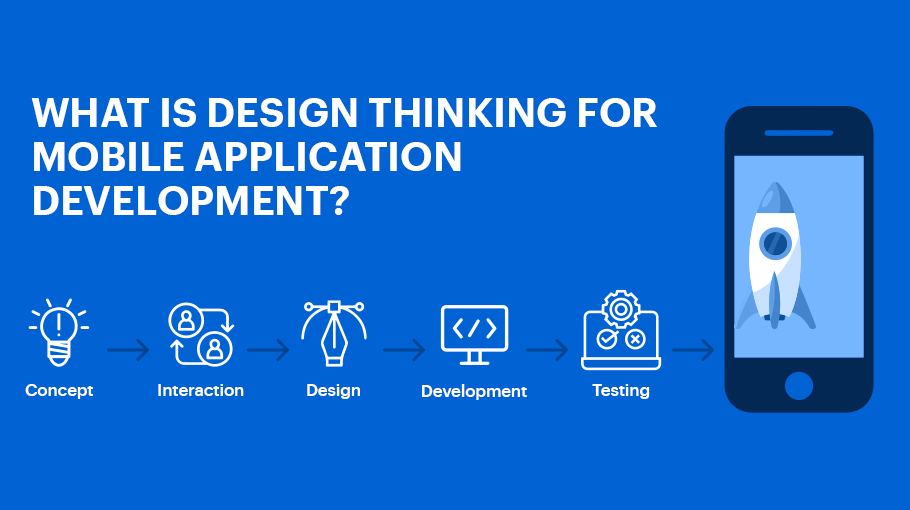
Over the past year, the concept of the design thinking process steps has gained ground in the mobile app industry, and leaders have been quick to identify its business benefits.
Well-designed mobile apps remove agitation along the user journey, resolve user pain points, and foresee issues users may not even see if it’s coming.
To gain such an advantage over the competition, enterprises project their interest in app development companies that understand business requirements and drift technology angle in the outcome.
Design Thinking Process Steps to build Mobile Apps?
Design thinking methodology is not restructuring an existing application or workflow. Now the question is what is design thinking?
It focuses on users needs, how they are going to be benefitted with it, what proves its individualism in the market, how mobile devices can help users to have right and accurate data, insightful information and expert advice.
The Problem Defined:
While the rural sales coordinators were already using the existing mobile app, it lacked the desired adoption rate, so they approached us to re-develop it.
They wanted to add more features to not only improve the adoption rate but also digitally enable the entrepreneurs.
In the midst of uncertainty, we need a model for action. We call this model the Loop, a continuous cycle of observing, reflecting, and making. Go in any order you like, take as many iterations as needed.
The thing about continuous improvement is that you’re never done. There will always be a better solution just around the corner.
The designing thinking process steps drive clients to understand the present and envision the future. It enables clients to build on their successes and learn from their failures along the way.
When taken to heart, the Loop keeps everyone moving forward despite the uncertainty the future may hold.
1. The approach
The design thinking approach consideration helped our client to understand that the app development should be carried out in a phased manner.
In Phase I, we built an app for the sales coordinators, including features like real-time stock updates and order placement, updates on order deliveries and collection schedules as well as integration with third-party distributors.
We also defined a roadmap for the digital enablement of the entrepreneurs, recommending training and workshops.
For Phase II, the design thinking process works as an app with tailor-made features for the entrepreneurs. Our research helped the client identify some vital features for the new app.
This new app, originally derived from the app designed in Phase I, has a simpler interface specifically designed in view of the low digital literacy of the users.
The user interface includes more graphics, bigger buttons, clear call to action buttons, and regional language support.
2. Design Thinking’s Phases
There are many variants of the Design Thinking process in use today, and they have from three to seven phases, stages, or modes. However, all variants of design thinking are very similar.
When competition is top-notch in the market, and everyone focuses on gaining customer loyalty; it starts with reaching customers at the right time as per their needs.
Customer experience can make or break a company, and word of mouth spreads among consumers in near-real-time quickly.
All variants of design thinking convey the same principles, which were first described by Nobel Prize laureate Herbert Simon in The Sciences of the Artificial in 1969.
3. Technical Feasibility
The design thinking approach starts with the end goal in the mind while we plan. It is a tool that helps companies to evaluate the feasibility of the required solution.
The starting point of the project is the end-user goals and requirements and how they can be translated into software. Design thinking approach helps an organization to visualize all the constraints, requirements, and end users clearly.
4. Clarity of Deliverable & Scope
The clarity of deliverables and scope of work is extremely important to make a project successful. When the projects are complex, it is hard to analyze all the given constraints, underlying patterns affecting the projects, and nail the scope of work.
But design thinking importance revolves around understanding the client’s needs, constraints, and assumptions effectively with designs.
The clients, end-users, and software development teams can effectively share notes using the design thinking approach. It helps in defining the deliverables and scope with clarity.
5. The Power of Storytelling
Why did we tell you this story? Telling stories can help us inspire opportunities, ideas, and solutions.
Stories are framed around real people and their lives. Stories are important because they are accounts of specific events, not general statements. They provide us with concrete details that help us imagine solutions to particular problems.
6. Allows Iterations and Ongoing Changes
The flexibility to incorporate changes as per user feedback helps in converging to the best solution. When a new product or service is released for the end-users, the iterations are done as per the feedback received.
The iterations and ongoing changes shape the final product/service. The enhancements and suggestions are also incorporated to make the product or service more appealing for the users.
Wrapping Up
While we had a fair idea of the problem, we had to solve it with a mobile app, the design thinking process steps included customer journey maps, ethnographic mapping, and surveys that enabled us to really do more for the problem and redefine the solution and guaranteed the desired results.
Design thinking makes communication and collaboration quite easy. It has transformed the way mobile app products and services are delivered to clients.
